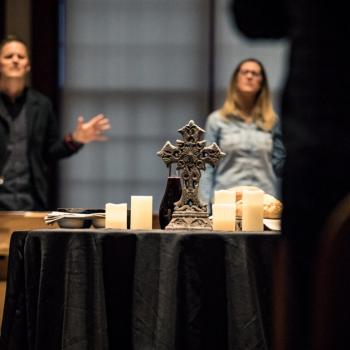This is the second post in a series titled: Mark 13… Signs of the Times? I invite you to check out that first post to catch up, so to speak 🙂 More posts to come on this topic!
Read the rest of the series here.
————————————————————-
We began this series by asking if we could look at natural disasters like earthquakes, as a sign that the so-called “end times” are coming all the more near. In this post, lets explore the “literary context” of Mark 13 and continue to wrestle with the interpretive and practical implications of how we choose to read this well know biblical passage. In doing so, perhaps the question in the back of our minds should be: Is the biblical story one that points toward hope for this world, or chaos and eventual destruction?
Mark 13 is a chapter that is often called a “little apocalypse,” although the whole of the book is gospel narrative. That is because, this chapter is clearly written with apocalyptic tradition in mind. Jesus is speaking prophetically in this passage and is using apocalyptic language to explain the things that will mark the fulfillment of his words. The question of “when” such a fulfillment will happen is not yet our task.
Our current task is to discern how this text relates to the rest of Mark. In Mark 11, Jesus returns to Jerusalem and is ushered in as the true King. Based on parallel accounts we know that this was “the first day of the week,” meaning that it was Sunday. According to this chapter, singing broke out as Jesus rode in on a colt. Some laid down their cloaks, while others began to wave palm branches. Those who chose to lay down their cloaks on this dusty road and waved palm branches were acknowledging that Jesus was indeed a king. This event has a clear connection with Zechariah 9.9 where this messianic moment is foretold.[1] The following day, “Jesus entered the temple courts and began driving out those who were buying and selling” (v. 15). Jesus cleared the Temple which should rightfully be understood as an enacted parabolic moment in which Jesus was casting judgment on the whole of the Temple system. This moment was what would lead to his death on the cross.[2] It is probably on Tuesday when Jesus continued to teach in parables and controversial sayings from the end of Mark 11.20 though chapter 13.[3] Following our chapter, 13, Mark’s narrative continues on to other significant events such as the last Passover on Thursday (Mk. 14.12-26), Good Friday’s crucifixion (Mk. 15), and then Sunday comes once again and Messiah is resurrected (Mk. 16).
There are some important literary issues that rise to the surface after placing this text in the larger context of the flow of the book of Mark. For instance, Jesus rides into Jerusalem as king in chapter 11. It is easy to imagine that those who were shouting “hosanna” on the road had no idea that another king would have him hung on a Roman cross by the end of the week. Nevertheless, this theme of Jesus as king connects throughout his various trials and accusations. Not only so, but a dominant image in our text sets up Jesus as being the “Son of Man.” As will be demonstrated, this language has deep connections to Daniel 7 where the “one like a son of man” is vindicated and given the status of royalty.[4] Another literary issue that becomes evident in the broader context is the prominence of the “fig tree” in chapter 11 and again in 13. Jesus curses the fig tree on his way to the temple, and the following day it is withered. There may be something worth exploring to understand the illustration towards the end of the third textual unit of the chapter. A third important connection that is made by placing our text within its broader literary context is the centrality of the Temple. Jesus enters Jerusalem as king on Sunday and heads directly to the Temple. The following day he returns and clears it out, enacting judgment on the system it represented. He then leaves again and on Tuesday returns and gives various kingdom teachings. It is on this day that he departs from the Temple and delivers the Olivet Discourse. After enacting judgment on the Temple, one day later and two chapters later, Jesus tells his disciples that it will be destroyed. This flow of events is significant to determining whose ‘signs of the times’ Jesus is trying to describe. Are these signs for followers of Jesus in modern day to watch for his coming or were these signs that the first century disciples were to watch for? After enacting judgment and then declaring destruction, could it be that all of the signs are linked to the Temple? If so, what are the implications for how we live today? Also, do you have any other thoughts on the “literary context” of Mark 13? Other thoughts or ideas? Counter-arguments so far?
[1]. N. T. Wright, Mark for Everyone(Louisville, KY: Westminster John Knox Press, 2004), 147.
[2]. See: Ibid., 149-54.
[3]. Zondervan TNIV Study Bible, ed. Kenneth L. Barker, John H. Stek, and Ronald Youngblood (Grand Rapids: Zondervan, 2006), 1702. See this resource for helpful chart on this page.
[4]. Wright, Mark for Everyone, 241.















